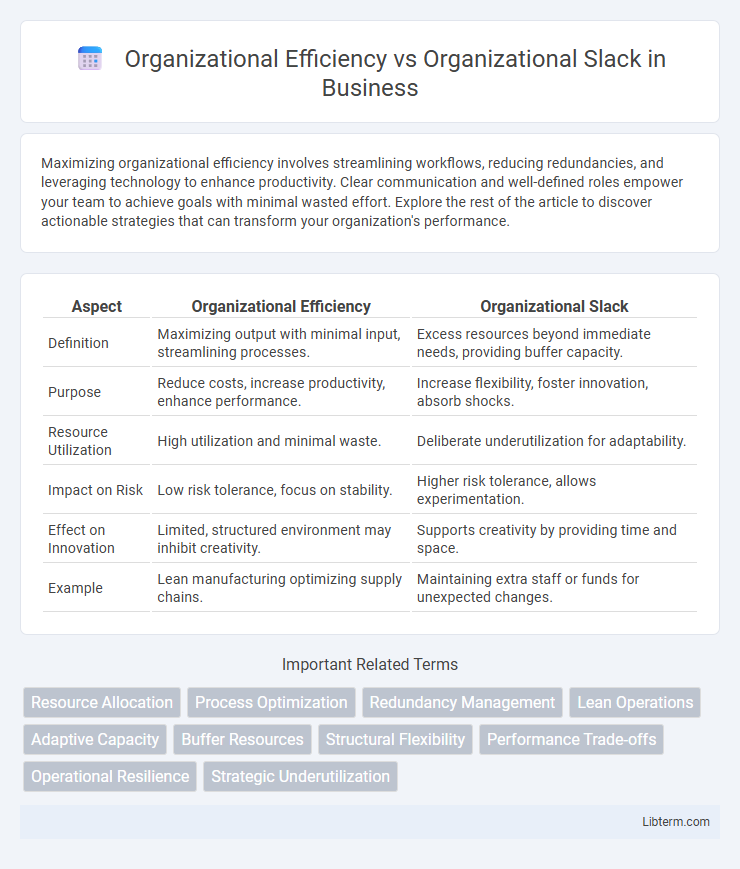Maximizing organizational efficiency involves streamlining workflows, reducing redundancies, and leveraging technology to enhance productivity. Clear communication and well-defined roles empower your team to achieve goals with minimal wasted effort. Explore the rest of the article to discover actionable strategies that can transform your organization's performance.
Table of Comparison
| Aspect | Organizational Efficiency | Organizational Slack |
|---|---|---|
| Definition | Maximizing output with minimal input, streamlining processes. | Excess resources beyond immediate needs, providing buffer capacity. |
| Purpose | Reduce costs, increase productivity, enhance performance. | Increase flexibility, foster innovation, absorb shocks. |
| Resource Utilization | High utilization and minimal waste. | Deliberate underutilization for adaptability. |
| Impact on Risk | Low risk tolerance, focus on stability. | Higher risk tolerance, allows experimentation. |
| Effect on Innovation | Limited, structured environment may inhibit creativity. | Supports creativity by providing time and space. |
| Example | Lean manufacturing optimizing supply chains. | Maintaining extra staff or funds for unexpected changes. |
Introduction to Organizational Efficiency and Slack
Organizational efficiency measures how effectively a company utilizes its resources to achieve goals, emphasizing cost reduction, productivity, and streamlined processes. Organizational slack represents the excess resources available beyond minimum requirements, providing flexibility and capacity for innovation, risk-taking, and adaptation to change. Understanding the balance between efficiency and slack is crucial for sustaining competitive advantage and long-term organizational resilience.
Defining Organizational Efficiency
Organizational efficiency refers to the optimal use of resources to achieve maximum productivity and minimize waste within a company's processes. It involves streamlining operations, reducing costs, and enhancing output quality to improve overall performance and competitiveness. High organizational efficiency directly contributes to increased profitability and sustainable growth by aligning resources with strategic objectives.
Understanding Organizational Slack
Organizational slack refers to the excess resources available within a company beyond what is necessary for immediate operations, providing a buffer to absorb shocks and enable innovation. This surplus capacity can enhance flexibility, allowing firms to adapt quickly to changes and pursue strategic opportunities without jeopardizing core activities. Understanding organizational slack is crucial for balancing efficiency, as too little slack may hinder responsiveness, while too much can lead to waste and reduced operational discipline.
Key Differences Between Efficiency and Slack
Organizational efficiency measures how well a company utilizes its resources to maximize output and minimize waste, emphasizing streamlined processes and cost reduction. Organizational slack refers to the availability of excess resources or buffer capacity that provides flexibility and resilience during uncertainties or unexpected challenges. The key difference lies in efficiency focusing on optimal resource use for productivity, while slack prioritizes maintaining additional capacity to support adaptability and innovation.
The Role of Slack in Innovation and Adaptability
Organizational slack refers to excess resources that provide a cushion for companies to experiment and adapt without immediate pressure for efficiency. Slack enables innovation by offering flexibility in resource allocation, allowing teams to explore creative solutions and respond rapidly to market changes. Maintaining a strategic balance between efficiency and slack fosters sustained adaptability and competitive advantage in dynamic business environments.
Risks of Excessive Organizational Slack
Excessive organizational slack can lead to resource wastage, decreased productivity, and increased operational costs, undermining overall efficiency. It creates complacency, reducing the urgency for innovation and timely decision-making, which can hinder competitive advantage. Moreover, surplus slack may result in blurred accountability and governance challenges, increasing the risk of organizational misalignment and strategic drift.
Strategies for Achieving Optimal Efficiency
Organizational efficiency is maximized by streamlining processes, leveraging technology, and implementing rigorous performance metrics to reduce waste and improve productivity. Organizational slack, comprising reserved resources and excess capacity, acts as a strategic buffer allowing for innovation and adaptation in dynamic environments. Balancing these elements requires agile resource management and continuous evaluation to ensure sufficient flexibility without compromising operational effectiveness.
Balancing Efficiency and Slack for Long-Term Success
Balancing organizational efficiency and organizational slack is crucial for sustaining long-term success, as efficiency drives streamlined processes and cost reduction, while slack provides the flexibility and resources needed for innovation and adapting to uncertainty. Excessive efficiency can lead to rigid structures that stifle creativity and responsiveness, whereas sufficient slack acts as a strategic buffer allowing firms to invest in development, absorb shocks, and seize emerging opportunities. Organizations that strategically manage this balance optimize resource utilization without compromising their capacity to evolve and maintain competitive advantage over time.
Case Studies: Efficiency vs Slack in Real Organizations
Case studies reveal that organizations with high efficiency prioritize streamlined processes and resource optimization, exemplified by Toyota's lean manufacturing system, which reduces waste and maximizes productivity. In contrast, companies like Google leverage organizational slack--excess resources and flexible time--to foster innovation and adaptability, enabling breakthrough projects such as Google X. Balancing organizational efficiency and slack is critical; failing to allocate slack can stifle creativity, while excessive slack may lead to resource underutilization and decreased competitive advantage.
Best Practices for Managing Organizational Resources
Organizational efficiency maximizes resource utilization by streamlining processes, minimizing waste, and aligning tasks with strategic goals, whereas organizational slack provides a buffer of excess resources to foster innovation and adaptability. Best practices for managing organizational resources balance these concepts by implementing continuous performance monitoring, flexible budgeting, and cross-functional collaboration to ensure resources are allocated prudently without stifling creativity. Leveraging data analytics for real-time decision-making and fostering a culture of transparency further enhances the ability to optimize efficiency while maintaining necessary slack for unforeseen challenges.
Organizational Efficiency Infographic

 libterm.com
libterm.com